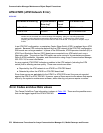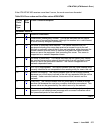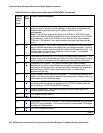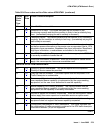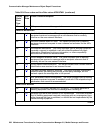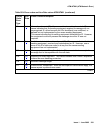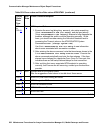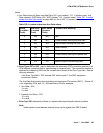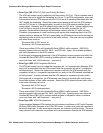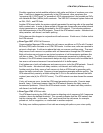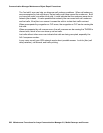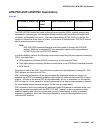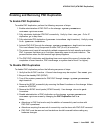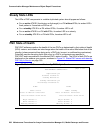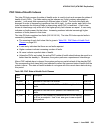
Communication Manager Maintenance-Object Repair Procedures
584 Maintenance Procedures for Avaya Communication Manager 3.0, Media Gateways and Servers
d. Error Type 769: ATM CLP (Cell Loss Priority) Bit Errors
The ATM cell header has a bit called the cell loss priority (CLP) bit. The bit indicates one of
two states: the cell is eligible for discarding, or it is not. In an ATM configuration, every cell
is transmitted into the ATM network with the CLP bit set to 0 indicating that these cells are
NOT eligible for discarding. Should the system ever receive a cell from the ATM network
with the CLP bit set to 1 (discard eligible), an entity in the ATM network modified the bit
during transit. Generally, an ATM network switch sets the CLP bit to 1 (discard eligible) only
if the cell fails to conform to the cell rate specified in the traffic contract for the VC.
However, Communication Manager cell emissions conform with the VC traffic contract.
Therefore, the presence of a non-conforming cell implies that something else in the ATM
network switch is setting the CLP bit in some cells, the ATM switch can also be policing out
(discarding) cells which do not conform to the traffic contract. This error can occur together
with other errors such as:
“Excessive AAL-5 CRC errors” or
“Excessive LAP-D retransmissions”
These errors affect SVCs with Variable Bit Rate (VBRnt) traffic contracts. VBR SVCs
transport system links such as EAL, PACL, and PRI links. Again, this indicates problems
with cell transmissions in the ATM network.
If cell discard is happening generically in the ATM network, other symptoms can affect the
Constant Bit Rate (CBR) SVCs including audible artifacts in talk paths, failure of modems
over voice lines, and “Cell Underruns” - see note (f).
e. Error Type 1025: ATM Congestion Bit Errors
The ATM cell header has a bit called the congestion bit. In Communication Manager ATM,
every cell is transmitted into the ATM network with the congestion bit set to 0 (congestion
not experienced). Should the system ever receive a cell from the ATM network with the
congestion bit set to 1 (congestion experienced), an entity in the ATM network modified the
bit during transit. It simply indicates that the ATM network is experiencing heavy traffic.
During periods of congestion, the ATM network can choose to discard cells even though
those cells conform to their traffic contracts. Should the ATM network discard cells, errors
such as the following can occur:
“Excessive AAL-5 CRC errors”
“Excessive LAP-D retransmissions”.
These errors affect SVCs with Variable Bit Rate (VBRnt) traffic contracts. VBR SVCs
transport system links such as EAL, PACL, and PRI links. Symptoms that can affect the
Constant Bit Rate (CBR) SVCs include audible artifacts in talk paths, failure of modems
over voice lines, and “cell Underruns” – see note (f).
f. Error Type 1281: ATM Cell Underruns
Communication Manager ATM monitors for cell underrun conditions on SVCs with Constant
Bit Rate (CBR) traffic contracts or on ATM CES trunks. In either case, cells are expected to
arrive at a fixed rate. If cells arrive below that rate, an underrun condition exists. The most
likely cause of cell underruns is a problem with cell transmission through the ATM network.



